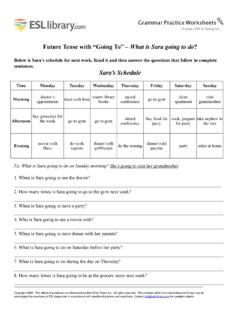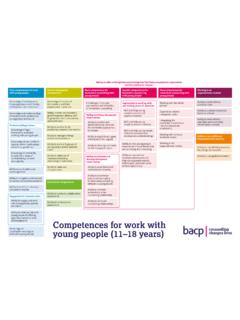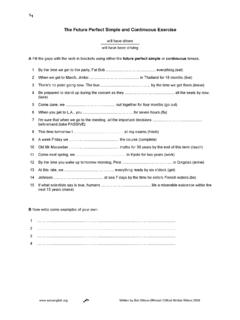Transcription of Organization Practice What employees are saying about the ...
1 Organization PracticeWhat employees are saying about the future of remote workEmployees want more certainty about postpandemic working arrangements even if you don t yet know what to tell 2021 Erlon Silva - TRI Digital/Getty Imagesby Andrea Alexander, Aaron De Smet, Meredith Langstaff, and Dan RavidAs organizations look to the postpandemic future , many are planning a hybrid virtual model that combines remote work with time in the office. This sensible decision follows solid productivity increases during the while productivity may have gone up, many employees report feeling anxious and burned out. Unless leaders address the sources of employee anxiety, pandemic-style productivity gains may prove unsustainable in the That s because anxiety is known to reduce job satisfaction, negatively affect interpersonal relationships with colleagues, and decrease work survey results make the source of anxiety clear: employees feel they ve yet to hear enough about their employers plans for post-COVID-19 working arrangements.
2 Organizations may have announced a general intent to embrace hybrid virtual work going forward, but too few of them, employees say, have shared detailed guidelines, policies, expectations, and approaches. And the lack of remote-relevant specifics is leaving employees organizational leaders chart the path toward the postpandemic world, they need to communicate more frequently with their employees even if their plans have yet to solidify fully. Organizations that have articulated more specific policies and approaches for the future workplace have seen employee well-being and productivity following charts examine our survey findings and shed light on what employees want from the future of Besides anxiety and burnout, longer-term productivity in a hybrid virtual model will also require addressing the organizational norms that help create a common culture, generate social cohesion, and build shared trust.
3 See Andrea Alexander, Aaron De Smet, and Mihir Mysore, Reimagining the postpandemic workforce, McKinsey Quarterly, July 7, employees are saying about the future of remote workExhibit 1 Organizations with clearer communication are seeing bene ts to employee well-being and <2020> <ReimagineWork>Exhibit <1> of <11>Note: All analyses conducted while controlling for all other predictors, region, industry, company size, job level, age, gender, and parental status (n = 4,854 5,043). Source: Reimagine work : Employee Survey (Dec 2020 Jan 2021, n = 5,043 full-time employees who work in corporate or government settings)Importance of communicating vision and policies on productivity, support, andinclusion,impact multiples1 2 3 4 5 Communicatingpost-COVID 19 visionFeelingsupportedFeelingincludedInd ividualproductivityCommunicatingremote-r elevantpoliciesOrganizations with clearer communication are seeing benefits to employee well-being and includedEven high-level communication about post-COVID-19 working arrangements boosts employee well-being and productivity (Exhibit 1).
4 But organizations that convey more detailed, remote-relevant policies and approaches see greater increases. employees who feel included in more detailed communication are nearly five times more likely to report increased productivity. Because communicating about the future can drive performance outcomes today, leaders should consider increasing the frequency of their employee updates both to share what s already decided and to communicate what is still employees are saying about the future of remote workCommunication breakdown Valuable as a detailed vision for postpandemic work might be to employees , 40 percent of them say they ve yet to hear about any vision from their organizations, and another 28 percent say that what they ve heard remains vague (Exhibit 2).
5 Exhibit 2 Most organizations have not clearly communicated a vision forpostpandemic <2020> <ReimagineWork>Exhibit <2> of <11>Source: Reimagine work : Employee Survey (Dec 2020 Jan 2021, n = 5,043 full-time employees who work in corporate or government settings) employees that report their Organization has communicated a post-pandemic vision,% survey participants322840 Well communicated Vaguely communicated Not communicated Most organizations have not clearly communicated a vision for postpandemic employees are saying about the future of remote workAnxiety at workAt organizations that are communicating vaguely, or not at all, about the future of postpandemic work , nearly half of employees say it s causing them concern or anxiety (Exhibit 3).
6 Anxiety is known to decrease work performance, reduce job satisfaction, and negatively affect interpersonal relationships with colleagues, among other ills. For the global economy, the loss of productivity because of poor mental health including anxiety might be as high as $1 trillion per 3 Individuals who are not being communicated to are feeling anxious aboutthe <2020> <ReimagineWork>Exhibit <3> of <11>Source: Reimagine work : Employee Survey (Dec 2020 Jan 2021, n = 5,043 full-time employees who work in corporate or government settings)The lack of clear vision or plan for postpandemic work is causing me concern or anxiety,% survey participants47%feel a lack of clear vision about the post-pandemic world is a cause for concernStronglydisagreeStronglyagreeDisa greeAgreeNeutral93835126 Individuals who are not being communicated to are feeling anxious about the employees are saying about the future of remote workBurning out The lack of clear communication about the future of postpandemic work also contributes to employee burnout.
7 Nearly half of employees surveyed say they re feeling some symptoms of being burned out at work (Exhibit 4). That may be an underestimate, since employees experiencing burnout are less likely to respond to survey requests, and the most burned-out individuals may have already left the workforce as have many women, who ve been disproportionately affected by the COVID-19 4 Web <2020> <ReimagineWork>Exhibit <4> of <11>Note: Burnout is likely underrepresented by our sample of full-time employees , as employees experiencing burnout are less likely to respond to survey requests, and those who feel most burned out may have already left the : Reimagine work .
8 Employee Survey (Dec 2020 Jan 2021, n = 5,043 full-time employees who work in corporate or government settings)Level of burnoutfelt by employees ,% survey participantsUSLatinAmericaEuropeAustrali aAsiaTotal49%of respondents saythey are feeling atleast somewhatburned outVery-low degreeLow degreeSomewhatHigh degreeVery-high degree2024291710172228221121312616620353 2103222928156272726137 Almost half of all employees report being at least somewhat burned out and that s likely an underrepresentation of the real half of all employees report being at least somewhat burned out and that s likely an underrepresentation of the real employees are saying about the future of remote workShare more Burnout is especially pronounced for people feeling anxious due to a lack of
9 Organizational communication (Exhibit 5). These employees were almost three times more likely to report feeling burned out. The obvious recommendation for organizational leaders: share more with employees , even if you re uncertain about the future , to help improve employee well-being 5 Web <2020> <ReimagineWork>Exhibit <5> of <11>Note: n = 4,854 5,043. All analyses conducted while controlling for feelings of support and inclusion, policy communication, region, industry, company size, job level, age, gender, and parental status. Source: Reimagine work : Employee Survey (Dec 2020 Jan 2021, n = 5,043 full-time employees who work in corporate or government settings)Lack of clear vision as a factor in causing anxiety, more likely to resultin moderate to highlevels of burnoutIndividuals who are feeling anxious due to a lack of organizational communication about the future are more likely to feel burned who are feeling anxious due to a lack of organizational communication about the future are more likely to feel burned employees are saying about the future of remote workEmployees want flexibility So how do organizations help their anxious and burned-out employees ?
10 One way is to find out what employees want for the future . More than half of employees told us they would like their organizations to adopt more flexible hybrid virtual-working models, in which employees are sometimes on-premises and sometimes working remotely (Exhibit 6). A hybrid model can help organizations make the most of talent wherever it resides, lower costs, and strengthen organizational 6 Web <2020> <ReimagineWork>Exhibit <6> of <11>Source: Reimagine work : Employee Survey (Dec 2020 Jan 2021, n = 5,043 full-time employees who work in corporate or government settings)Working models pre-COVID 19 and desired working models post-COVID 19, % survey participantsMost employees would prefer a more exible working model after the pandemic is over.



